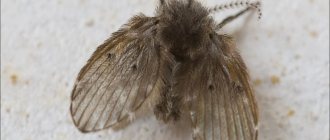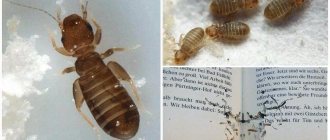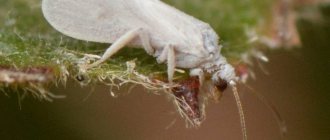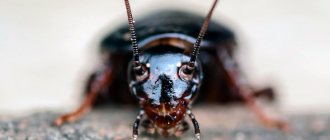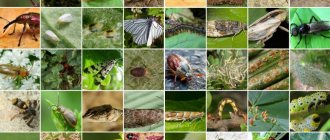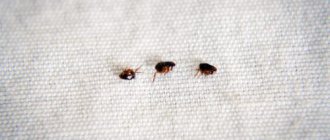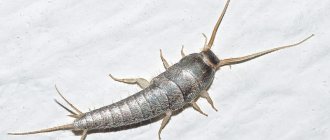Views: 1,282
Sewer moth fly
Sometimes in the house you can observe the appearance of small flies that look like small butterflies. They grow in places where there is high humidity . Most often this is a bathroom, toilet, kitchen. In apartment buildings and private buildings, they can also be found in basements and other similar poorly ventilated places where excess moisture accumulates. These are butterflies, or sewer flies .
These insects do not pose a direct threat to human health and life . However, their appearance is still annoying. With strong reproduction, butterflies form a whole swarm. They fill the living space, clinging to the ceiling and walls above their habitat. What kind of insects are these, why they appear in the house and how to get rid of the butterfly , we will tell you in this article.
What kind of fly is the sewer butterfly?
Butterflies are the closest relatives of mosquitoes - small dipterous blood-sucking insects. However, unlike them, butterflies do not feed on blood. They are herbivores . They prefer rotting plant remains, accumulations of bacteria and microscopic fungi. From this point of view, they are much less harmful than their carnivorous relatives, who are capable of transmitting pathogens of serious diseases. Therefore, as a rule, they are not classified as dangerous insect species .
Butterfly photo from the side
However, they are still annoying. What do these winged arthropods look like? Outwardly they are very attractive. Miniature, up to 4 mm in size, tiny “butterflies” . They have characteristic oval wings that are large for their size. Body color is dark, grayish-brown. Sometimes graphite black.
The entire body of butterflies is heavily hairy , which increases their resemblance to moths. The legs are thick and short. On the head there are long, clearly visible, feathery antennae. In general, unlike many other insects, they do not look repulsive. Quite cute midges.
Description of the insect
The butterfly appeared during the Jurassic period, when there were no sewers yet. At the same time, the insect managed to survive and adapt to modern life. There are 2,500 species of butterflies in the world.
An adult sewer fly reaches 3 mm. Most of the body and wings are covered with dense hairs resembling fluff. The chest and back of the insect are dark gray. The wings shimmer with all the colors of the rainbow.
Important: the color of an insect can differ radically, as it depends on the region where it lives.
The life cycle of a sewer fly goes through 4 phases:
- egg;
- larva;
- chrysalis;
- imago.
The adult lays eggs in places with high humidity. Their number can reach 100 pieces. The eggs are light brown or yellowish.
The larva is born after 2-3 days. Her body is worm-like. Reaches 7 mm. The insect feeds on the remains of organic decomposition.
The pupation process begins on the 21st day of life. The adult appears after 12-15 days.
Where do sewer flies live?
Butterflies that appear in human homes are synanthropic insect species. This means that the most favorable conditions for their life are created next to people. Basically, two conditions are important for sewer moths - humidity and organic debris on which they feed. Reduced illumination up to complete darkness (as in basements) and cool air are welcome. That is why the massive and active appearance of these insects can be observed, as a rule, in the off-season .
Butterflies in apartments breed most often in drains or in clogged places with constant humidity . Therefore, their appearance often indicates a violation of sanitary and hygienic standards in the home. This is what you need to pay attention to first in case of their invasion.
Reasons for the appearance of midges in the bathroom
Where it is humid, it is comfortable for small midges. There are places in the apartment where there are the most favorable conditions conducive to the appearance of these insects. Butterflies can settle in the toilet and kitchen.
Important! Most often, midges live in the bathroom, where unsanitary conditions “reign” - order is rarely restored, and the pet’s toilet does not take a long time to be cleaned.
It's not just humidity that attracts insects. They are sensitive to the smell of decaying food. If there are midges in the house, the reason should also be sought in the following:
- sewerage blockages and leaks;
- rotting food debris accidentally falling into the drain;
- trash cans that are not emptied regularly;
- unfavorable neighborhood.
Midges can live in flower pots if you keep them in the bathroom. This often provokes the development of fungal diseases in houseplants.
How do butterflies develop?
Adult insects may not feed. However, the larvae need decaying remains of plant organic matter . They can be found in abundance in sewers and other similar places. There, the adult insects lay their eggs, which hatch into tiny larvae after a couple of days . Within a week, the worm-like larva turns into a miniature fly. After another two weeks, the insect reaches an adult state in which it is capable of producing its own offspring.
Thus, in just over three weeks, sewer flies go through the entire development cycle and turn from eggs into sexually mature individuals. At the same time, butterflies are quite prolific. One clutch of eggs can contain up to 100 young . Of course, not all of them survive to adulthood. However, those who do survive are enough to quickly increase their population if this is not resisted.
Adult butterflies are usually quite lazy . They don't fly much. And if they do fly, it is for very short distances. They mostly sit on walls near their breeding sites.
Useful tips
Many housewives use the bathroom to wash fruits and vegetables. It’s better not to do this, because even the slightest piece of fruit remaining after washing will inevitably rot, thereby attracting midges.
You can hang adhesive tape in the bathroom. For a large concentration of midges, it is not a hindrance, but if they have appeared recently and the number of individuals is small, this tool will help catch the insects before they reproduce.
Dichlorvos odorless Neo 600 ml
If you don’t want to spend a lot of time killing insects, you can use regular dichlorvos. It is advisable to do this on a day off, when the whole family has the opportunity to go for a long walk. Treat and close the bathroom tightly, after returning, ventilate and thoroughly wash the surfaces with a cleaning product.
This is how, using simple tips, choosing the right product and following standard rules for cleaning premises, you can prevent the appearance of unpleasant domestic insects. Knowing how to deal with them, you can quickly get rid of such a neighborhood if they have already appeared, without putting in much effort. The main thing is to begin a merciless fight as soon as at least one midge is discovered. This ensures that the bathroom is always clean, free of flying or crawling insects.
How to get rid of a butterfly?
Butterflies in the bathroom or kitchen are the first sign of clogged drains. Therefore , the first thing to do in this case is to clean the pipes . It doesn’t matter how – mechanically using a plunger or using chemicals. Both methods allow you to remove butterfly larvae from their habitats.
Adult insects can be easily gotten rid of with any insecticidal aerosol or simply by killing them mechanically. Both highly toxic products such as dichlorvos and specially designed aerosols against mosquitoes and other flying insects (Mosquitol, Raptor and others) are suitable as a spray. It is quite appropriate here to use plates and fumigators, as well as mosquito coils .
In any case, it is important not to be indoors at this time . Especially when using highly toxic drugs. Upon returning home, the space should be well ventilated. When using fumigators to destroy butterflies, it is not necessary to leave your home. However, windows must be open for adequate air circulation and ventilation.
All this is true both for residential premises and for basements or outbuildings. Such measures may be enough to get rid of butterflies. However, if the infestation of insects is very strong or you do not want to deal with their removal yourself, then contact our disinfection service “Nymphadez” . We will quickly resolve this problem.
How to kill sewer flies: 6 best remedies
Photos of what you need to get rid of forever
There can be many different types of flies and flies flying around your home, including sewer flies and fruit flies. But it is quite difficult to distinguish them correctly. To do this, you need to know the characteristics of the habitat of each type of fly. Fruit flies fly near food, juices, sweets and fermented, spoiled fruits. At the same time, sewer (drain) flies love garbage, pipes and damp places. They live near kitchen sinks, in bathrooms, sewer pipes, and in damp soil. These flies can accidentally enter the human body along with inhaled air and cause harm. You definitely need to get rid of them!
And we are ready to arm you! Believe me, if you learn more about the behavior of these insects and choose the right methods of prevention and destruction of flies, they will leave your home very soon!
What do sewer flies look like?
These are small (<2 mm) black flies with short, hairy bodies and wings, which gives them a “fluffy” moth-like appearance. Adults have long antennae and leaf-shaped wings. You can recognize drain flies not so much by their color and size as by their behavior. These flies are active in the evening, but during the daytime they are not active and sit somewhere on the walls.
These flies do not fly well, so they mostly stay indoors, crawl and only occasionally fly. And they don’t live long – about 2 weeks. The life cycle of drain flies contains several stages. The larvae of these flies and flies at the pupal stage live in thin films in drainpipes and septic tanks. The larvae feed on microscopic plants and decaying organic matter. The duration of the larval stage is about 9 to 15 days, and the pupal stage lasts for 20-40 hours. Adult flies that emerge from the pupae are considered fully mature and begin to reproduce rapidly, laying 30 to 100 eggs at a time.
Why are sewer flies dangerous?
- They infect you through your food. Sewer flies love to sit on your sandwiches and jam, especially if the kitchen table is next to the sink. At this time, there is a lot of infection on their paws, picked up in the decomposition zone. From pieces of dirt to very dangerous bacteria.
- Sewer flies in the bathroom are dangerous for a child. You should not bathe your baby near a breeding ground for drain flies. They can fly into his eyes, mouth... and in general, this is a dangerous neighborhood.
- They bring their friends to you. Sewer flies and their babies are also a breeding ground. But already for larger insects. Following them, spiders, larger flies and other creatures may appear in your house.
- Allergy. These are, of course, not bees or wasps, but medicine knows cases of acute allergic reactions to sewer flies.
- Identify the enemy and the source of reproduction. Place pieces of duct tape around the sink, preferably close to the drain. You can even partially seal it. If in the morning you see dead flies on them, then you can move on to the next step.
- Carry out mechanical cleaning of the pipes using a brush or cable. Make sure there is no hair, rotting food or other organic matter left inside. To do this, you can use, for example, a universal flexible brush for cleaning pipes.
- Slowly pour boiling water over the drain: one pan of hot water is enough. It will destroy a significant part of the larvae and eggs.
- Pour the chemical there. pipe cleaner. But you should always read the instructions for use and follow its conditions. The chemical gel may have to be refilled several times a week.
- Finish off the remaining survivors with a fly swatter!
How to protect your home from fly infestation?
To understand where sewer flies come from, you need to know what attracts them. This list includes: trash cans, clogged, dirty drains in sinks and bathrooms, stagnant water in any place, as well as potted flowers indoors - flies love wet soil.
In general, the prevention method is very simple: you need to regularly clean all the sinks and drains in your home. Inspect all drains in the home and any areas inside or outside the home where there is standing water. The optimal regime for preventive cleaning of sewer pipes is once a month, especially if your home and the sewer system in it have been in service for many years.
Getting rid of drain flies: cleaning pipes
The first and perhaps most important stage in the process of getting rid of flies is cleaning the pipes. This is a preparatory stage, but an extremely necessary one. Because if you don’t do it, then even if you use special means you won’t remove flies forever.
And, only after you have cleaned the pipes, use special professional products. We will tell you about the best traps, gels, growth regulators and other useful means of combating flies.
Prevention measures
In the case of the fight against sewer moths, preventive measures play an important role. Getting rid of a butterfly is not that difficult. It is much more difficult to prevent its re-settlement and reproduction . And to do this, it is necessary to eliminate the causes that contribute to its appearance and create favorable conditions for the life of these insects.
What do we have to do:
. Both mechanical and chemical methods are suitable.
Clean drains regularly and promptly- Do not allow water to stagnate and dampness to form on any surfaces . Immediately remove excess moisture.
- Fix water leaks and plumbing problems in a timely manner.
- Install fine-mesh mesh on the ventilation openings to prevent butterflies from entering from basements, neighbors, etc. It is recommended to do this to protect not only from butterflies. Such measures greatly help to avoid the invasion of cockroaches, bedbugs, fleas, mosquitoes and other unpleasant insects traveling through ventilation.
- Cracks in walls and floors must be repaired . Again, this helps create difficult conditions for survival not only for butterflies, but also for many other much more dangerous parasites.
- It is important that the room is sufficiently heated, ventilated and dried . At all costs, you should avoid high humidity in places where moisture can accumulate.
- Maintain cleanliness and order in the house , eliminating with cleaning agents possible accumulations of plant organic matter in hard-to-reach areas, especially those exposed to water.
On the one hand, they are another unpleasant side effect of high humidity and a signal that proper control measures need to be taken. On the other hand, sewer moths can also feed on this mold. Therefore, in any case, you need to get rid of mold. And as quickly as possible.
Get rid of mold and mildew.
Following these simple rules will allow you to permanently get rid of the butterfly in the house and prevent its reappearance.
Other articles on the topic:
– How to protect yourself from mold: causes and habitats
– Elimination of odors with dry fog
– Mold removal: do it yourself or turn to professionals?
– What is disinfestation? Types of disinfestation.
Making a trap
If there is no possibility or desire to use chemicals or simple mixtures, you can make a trap that will help you quickly get rid of insects. It's very easy to do.
Take a small glass container (glass or jar), put a piece of banana or apple in it. Roll up a thick sheet of paper and place it in the jar, with the wide opening facing out. Attach the funnel to the container using tape.
Options for midge traps
That's it, the trap is ready. Midges will be able to fly in to the smell of rotting fruit, but they will not be able to get out of the trap. All you have to do is wait until there are a lot of representatives of the annoying family in the jar, take out the paper funnel and fill the container with boiling water.
Then you need to pour the dead midges into the toilet, put in a new bait and install the paper funnel again. You can install several such traps, this guarantees that the insects will completely disappear after a while. The main thing is not to forget to check the banks periodically.
